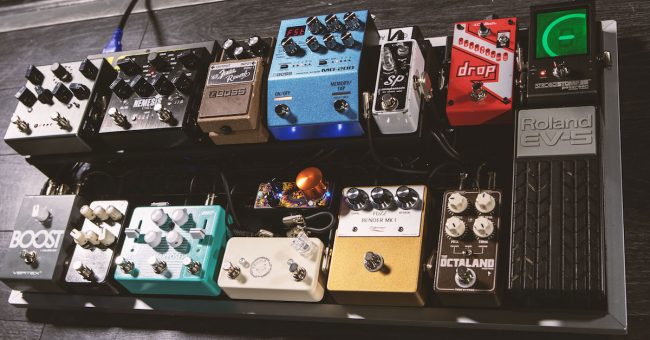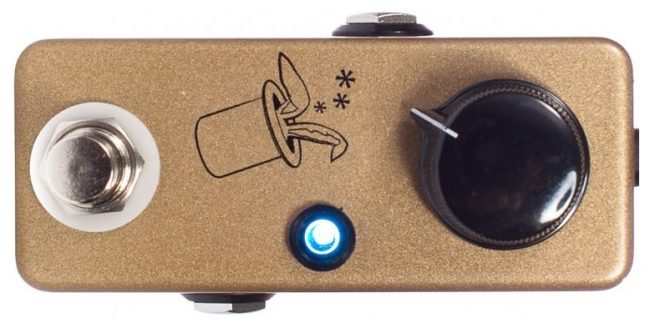
Above: RJ Ronquillo’s Pedalboard
No one wants tone suck in a pedalboard, but sometimes it seems no one can agree on the best way to avoid it. That’s because the solution depends on your particular setup, so what works best in one situation might not work well in another. But no worries — once you know the ways pedals can affect your sound, then you’ll know exactly what to do.
First, let’s look at how pedals are bypassed. Fig. 1 shows the three main options; the gray resistor symbol represents the effect’s input impedance. Because a low input impedance can cause audible signal loss, it’s sort of like putting a “load” on the previous stage that makes it work harder — hence the term “loading” to describe the effect a low input impedance has on passive guitar pickups. Loading can reduce level, high-frequency response, or both with passive guitar pickups.

True bypass (sometimes called “hard bypass”): Bypassing the effect disconnects the input and output jack from the pedal’s electronics and connects them together directly. When bypassed, the input impedance has no effect on your sound.
Standard bypass: Bypassing the effect disconnects the output jack from the pedal’s electronics and connects the output to the input. However, your guitar remains connected to the effect’s electronics, so the input impedance is still a factor.
Internal bypass: The effect remains in the signal chain, and bypassing occurs electronically within the effect. A simple example would be reverb: bypassing could simply force the wet/dry mix control to be all dry signal. Or, there may be internal electronic switching. Note that the input impedance can still affect your signal.
Buffered pedal: Buffering is not a bypassing technology but a description of the pedal’s input circuitry. A buffered input places very little loading on your guitar (we’ll cover this in more detail later), which can help preserve tone. The buffer circuitry may or may not remain in the signal path when you bypass the effect; one of the features of BOSS, Ibanez, and several other pedals is that their inputs buffer the signal, even with the effect bypassed.
True Bypass — Marketing Hype or Useful Technology?
When using standard bypass or even internal bypass, the input circuitry always loads down your guitar, even when bypassed. If the effect feeds another effect with standard bypass, the second effect will add more loading when bypassed. So, on the surface, the alternative true bypass may seem like the best way to bypass — with all electronics out of the signal path, you will have a pure tone from guitar to amp with no added noise or distortion. However, this isn’t always what you want. Here’s why true bypass is sometimes the less desirable option for pedals in a pedalboard.
The type of bypassing matters because guitars with passive pickups deliver the most output and high-frequency response when feeding a high-impedance (e.g., 200,000 ohms to 5,000,000 ohms) amp, buffer, effect, or audio-interface input. The Tone Suck Tester project described later lets you confirm whether an effect input loads down your guitar, but remember that loading is cumulative. With standard passive pickups, an input impedance of 200,000 ohms will have little, if any, noticeable effect on brightness. But if two effects with a 200,000 input are connected in series, both using standard bypassing, and then are both bypassed, now the input impedance is 200,000 divided by two — 100,000 ohms. You’ll probably hear some dulling. If there are three similar pedals that are all bypassed, then the input impedance becomes 200,000 divided by three; and with an input impedance of 66,000 ohms, you will almost certainly hear a significant amount of dulling and some volume loss.
In addition to input impedance, cable capacitance also affects tone. A guitar’s tone control works by connecting a capacitor from the hot signal to ground. A cable has a certain amount of capacitance between the hot lead and the shield, so it basically acts like a secondary tone control that’s always on. The amount of capacitance is very small compared to a tone-control capacitor. However, cable capacitance is cumulative — a 50-foot guitar cord will have five times the capacitance of a 10-foot guitar cord using the same cable.
To complicate matters further, although higher impedances load down your guitar less, cable capacitance theoretically has more of an effect with high impedances. This is a small difference at best… but you know how picky guitar players can be about tone.
Let’s Jump to the Solution!
If you’re about to bail at this point because we’re getting too nerdy, then let’s present the two simplest solutions. Active guitar pickups, like Fishman’s Fluence pickups (fig. 2), have a low output impedance that minimizes sonic degradation caused by subsequent effects and cables.

For guitars with passive pickups, the easiest solution is to have your first “effect” be an electronic buffer circuit with a high input impedance to minimize loading your guitar and a low output impedance to minimize any degradation caused by subsequent effects and cables. Buffer pedals come in all shapes, sizes, and price ranges; even a relatively basic model like the JHS Prestige Buffer/Boost (fig. 3) goes beyond being only a buffer by providing gain, so it serves double duty as a straight buffer or as a pedal that can increase the drive going to an amp. Note that you’ll want to place a buffer first in the signal chain, and leave it in at all times, to provide the advantages of buffering.

But you may not even need a separate buffer pedal. As mentioned earlier, many pedals, particularly those made by BOSS and Ibanez, include a buffer that remains in the signal path even when the effect is bypassed. So, if your first pedal is something like a tuner, compressor, or gain boost that includes a buffer, then you’re covered for buffering.
As expected, there are some tradeoffs. Because a buffer is active, it will generate some noise; and being first in the chain means that any subsequent high-gain effects will amplify that noise. Realistically, though, any noise the buffer generates will typically be a lot less than the hum and other garbage that passive pickups themselves produce.
And let’s throw another variable into the mix: Some guitarists prefer the sound of effects or cables that load down the guitar. Similarly to how turning down a tone control when feeding distortion can give a smoother, creamier sound, loading and the cable capacitance’s ability to reduce highs might be desirable. A guitar player who’s used to playing through 50 feet of cable onstage with effects that load down the guitar’s pickups might be dissatisfied in the studio when going through short cables into a high-impedance audio interface that preserves a bright, present sound.
Finally, if your pedalboard consists of multiple pedals that all have buffers, then that’s a fair amount of redundant circuitry. You need a buffer at the beginning of the signal chain and maybe at the end if you’re feeding a long cable to an amp or interface, but otherwise you don’t need a bunch of buffers between the beginning and end. All they do is add extra stages of active circuitry.
So, now you have solutions: Use active pickups; or insert a buffer as your first effect, leave it in, and don’t look back! Class dismissed. But if you want a master’s degree in effects bypassing, let’s dig even deeper to explain the theory behind this.
The Problem with True Bypass
In the studio, you’re usually dealing with short cable runs, a limited number of effects, and a high-impedance input from an audio interface’s direct input. In this case, true bypassing works to your advantage — if you bypass the effect, there won’t be any active electronics to contribute noise. Then again, the point is probably moot. If you don’t want the effect, you can just overdub an effect-less guitar sound on a different track.
Live performance, with pedalboards and long cable runs, presents a very different situation. If all your pedals use true bypass and they’re all bypassed, although your guitar sound won’t be affected by the various effects’ input impedances, it will be degraded by the accumulated capacitance of all your cables onstage. Now suppose you enable an effect. Its low impedance output won’t be as affected by the cables, so your tone will change unpredictably as you enable and bypass different effects. However, assuming your effects have reasonably high-impedance inputs, using active pickups will help solve your tone problems, as will using a buffered first effect pedal or a wireless guitar-to-pedalboard transmitter/receiver combo that eliminates long cable runs altogether. (Interestingly, if cable capacitance is part of your sound, the Line 6 Relay G10S also provides the option to emulate the sound of going through a 10- or 30-foot cable.)

The bottom line is that, depending on your setup, true bypass can improve your tone, degrade it, or make no difference — it depends on the rest of your effects, their placement in the chain, cable lengths, and whether you use wireless. But if your guitar always feeds a high-impedance device that transforms the signal into a low output impedance (via a buffer, effect, or wireless receiver) before your effects chain, then true bypass — or the lack thereof — will have little, if any, effect on your tone.
Ultimately, though, your ears won’t lie to you. You won’t hurt anything by mixing and matching different types of pedals. Although placing a buffer first eliminates a lot of variables, they may be variables you don’t want to eliminate. As always, the only “rule” is to do what sounds right to you, not what may or may not be best from a theoretical standpoint.
The Tone Suck Tester
The Tone Suck Tester (fig. 5) can help you find out whether an effect loads down passive pickups enough to produce a noticeable dulling of tone or loss of volume — and it’s super easy to build. The schematic shows a version that can test three effects simultaneously to check for cumulative loading, but you can add more jacks to test more effects at a time or use a single effect jack if you just want to test individual effects.

Plug your guitar into “from guitar” and patch “to amp” to your amp or audio interface. To find out if an effect loads down your signal, make sure the effect being tested has power, then plug its input into the “effect #1” jack. Toggle the effect between enabled and bypassed and open/close the associated switch to listen for differences.
- If enabling the effect causes a loss of tone but bypassing it doesn’t, then the effect probably has true bypass.
- If there’s tone loss regardless of whether the effect is bypass or enabled, then there’s likely standard bypass.
- If there’s no detectable tone loss regardless of whether the effect is bypassed or enabled, then the effect is likely either a buffered type or a well-designed effect that uses true or standard bypassing but that has a high input impedance.
If all your effects use standard bypass, then the more effects you use, the more loading will accumulate if you don’t use active pickups or have a buffer as your first pedal. You can plug in several effects, as described previously, and open/close switches to hear which combination of effects loads down your guitar the most.
Link: https://www.sweetwater.com/insync/what-are-the-differences-between-buffered-and-true-bypass-pedals/
